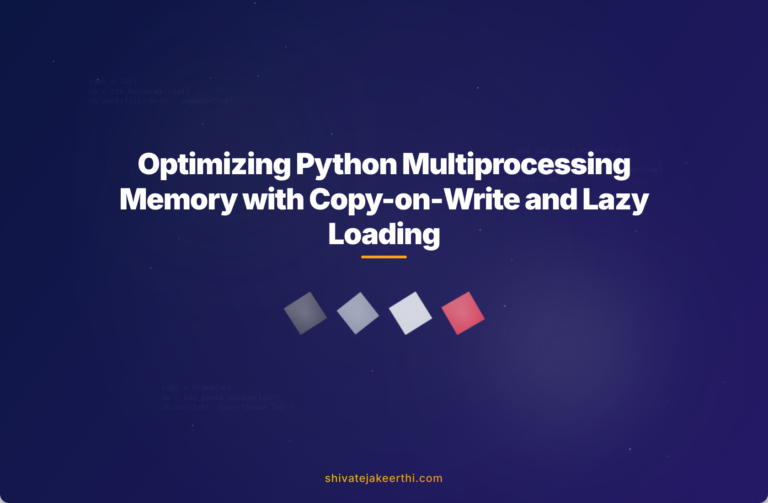When you start exploring the multiprocessing module in Python, someone inevitably brings up the idea of copy-on-write memory management. It sounds technical, but here’s the essence: copy-on-write is a smart trick operating systems use to prevent unnecessary duplication of memory when creating child processes.
Think of it like a shared recipe book you pass out to multiple cooks. Instead of making a brand-new copy for each chef, you give them all the same copy. They only rewrite pages (using new memory) if they make any changes. The same principle applies to Python processes.
To understand Python multiprocessing and the actual memory usage pattern, we performed a simple experiment: load a huge 10GB object into memory in the main process and pass this object to four multiprocessing workers. Each worker modifies the object’s data to observe memory usage.
Setting Up the Experiment: Using a Large 10GB File
First, we create a sizable object by reading a large file into memory. Let’s take a quick look at how you’d load that huge file into a Python object.
# Loading a 10GB large file into memory
def load_big_file():
with open('big_file.bin', 'rb') as f:
large_object = f.read()
return large_object
if __name__ == '__main__':
big_data = load_big_file()
This step loads about 10GB worth of data into RAM directly. Our next step involves giving each multiprocessing worker a portion of the large object and modifying its content slightly to trigger potential copy-on-write behavior.
We set up four multiprocessing workers, each assigned a portion of the large object. Here’s how your multiprocessing script might look:
import multiprocessing
def process_chunk(chunk):
# Modify the chunk data slightly to trigger memory duplication
modified_chunk = bytearray(chunk)
modified_chunk[0] = (modified_chunk[0] + 1) % 256
return len(modified_chunk)
if __name__ == '__main__':
large_object = load_big_file()
# Divide the object into 4 equal segments
chunk_size = len(large_object) // 4
chunks = [large_object[i*chunk_size : (i+1)*chunk_size] for i in range(4)]
with multiprocessing.Pool(processes=4) as pool:
results = pool.map(process_chunk, chunks)
print(results)
Now, process_chunk slightly alters the data to trigger the copy-on-write mechanism clearly.
What Memory Usage Do We Expect?
At first glance, expectation naturally tells us that spawning four workers each modifying a 10GB object should lead to immense memory usage. One might think it would balloon to around 50GB total:
- 10GB from the original object in the main process
- 10GB for each of the four workers (due to copy-on-write)
That adds up quickly to 50GB of RAM usage. It’s a simple calculation—each process needs its own copy since we’re changing the data in every worker. Or does it?
Surprising Actual Memory Consumption Observed
In practice, monitoring our running system tells a different story. Instead of jumping to around 50GB, memory consumption hits only about 20GB or slightly more. This scenario raises interesting questions. Why isn’t it consuming the expected amount of RAM?
The mystery lies in how your operating system and Python interact. When Python multiprocessing forks processes, it doesn’t instantly duplicate memory. Instead, it allows workers to share memory initially—only allocating new memory pages if and when they’re changed. But that doesn’t explain everything.
Exploring Python’s Lazy Loading & Granular Copy Mechanism
In reality, what’s happening under the hood involves concepts known as copy-on-write and Python’s memory handling strategy with multiprocessing. Here’s the core difference between this actual behavior and the expectation:
- Granularity of Memory Pages: Operating systems break down memory into pages (often 4KB in size). When you modify data, the OS only duplicates necessary pages instead of the entire object’s memory space.
- Lazy Loading: Python and modern operating systems are smart enough not to load or duplicate entire massive objects immediately. Instead, they allocate memory as required.
Imagine copying a 10,000-page book. If you correct a typo on page three, would you photocopy all 10,000 pages again? Of course not—you’d copy only page three. Copy-on-write works similarly, significantly reducing the actual memory consumed.
Furthermore, Python does not eagerly duplicate memory blocks when processes fork. It uses a fork() system call (particularly on Unix-based systems). Initially, both processes share identical copies of all memory; only pages that change become distinct copies. The operating system manages this behavior transparently for Python.
Why Does Python Multiprocessing Only Double Memory in This Scenario?
In our test, even though each worker modifies the data, they only change a tiny portion—just one byte at the beginning of a big chunk (several GB in size). The consequence? Each process only creates a few new memory pages for these isolated changes rather than entirely new copies for the complete 10GB segment. That’s why memory usage reaches just around 20GB instead of ballooning to 50GB.
If we drastically alter every little byte of the segment inside the workers, you’d see much more significant memory usage—it could indeed approach our original projection.
Python manages memory allocation and multiprocessing carefully, and understanding this helps when working with large datasets or performance-critical code. You can dive deeper into how Python shares and copies objects between processes on books, blogs, or Stack Overflow’s Python multiprocessing resources.
Implications & Suggestions for Further Experiments
Understanding Python multiprocessing’s memory handling and copy-on-write behavior can significantly impact your application’s performance and efficiency. Holding unrealistic assumptions might lead you to unnecessarily limit memory or resources, impacting the application’s performance negatively.
Experimentation and exploration remain keys to accurately measure memory allocation patterns:
- Modify varying extents of big data objects within child processes.
- Monitor actual memory usage comprehensively using tools like htop or other specialized Python performance monitoring utilities.
- Test across various Python implementations and operating systems.
Doing so helps paint a clearer picture and ensures better decision-making when designing high-performance Python multiprocessing applications.
Have you ever encountered unusual or unexpected memory behaviors with Python multiprocessing? Share your experience or questions in the comments below—let’s exchange insights and practical solutions!



0 Comments